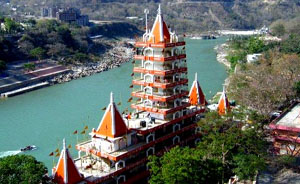
RishikeshThe holy town of Rishikesh has the eminence of being the International capital of Yoga and meditation. Located in the foothills of the Himalayas on the banks of the River Ganges, Rishikesh is dotted with a number of ancient temples, ashrams and world renowned yoga and meditation centres. Not only devotees, but travellers from all parts of the world flock to the sacred town for a deeper understanding of meditation. At the ashrams in Rishikesh, visitors can attend lectures and courses offered by celebrated yoga and meditation experts. Apart from Hindu shrines, the town of Rishikesh also invites adventure lovers from all around. It is also the ideal gateway for a pilgrim chardham yatra, that includes travelling to Yamunotri, Gangotri, Badrinath and Kedarnath.
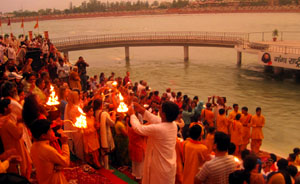
Rishikesh Ganga Aarti. Evening in Rishikesh are for sitting by the Ganges and while away your time. Later in the evening, you headed towards Parmarth Niketan Ashram to witness the daily evening ritual of Ganga Aarti.
The aarti is a pleasant ritual of worshipping the Ganga. Around 50-100 people visit the aarti on any day. You have witnessed Ganga Aarati in other places like Haridwar and Varanasi too, but they are a crowded noisy ritual with loud screaming speakers, people troubling you to make donations or hawkers trying to sell something highly overpriced. The Aarti at Rishikesh is a contrast to it, held in a small place with a few people and is a relatively quite affair. You can sit quietly in a corner and witness the ritual or join the crowds singing Bhajans with them.
The Aarati happens at a very picturesque place on the banks of Ganga, in front of a Shiva statue built on the river. You see some activity beginning at the riverbank around 5pm. People start cleaning up the area, lay carpets in preparation for the aarati.
A few people are seen selling deep or diya - a flower bowl with a wick lamp to be floated down the river during the Aarti after prayers.Terivani Ghat Ganga Aarti. It starts at 5.30pm, with children studying Veda, the Bhajan singers and the performers walking into the ghat in front of Parmarth Niketan. It begins with Bhajans and prayers for Gangaji and Shiva.
It is interesting to watch the children as the ritual progresses. They look bright and alive in their saffron robes. Some of them appear oblivious of the whole thing and drift into their own world. A few start a conversation within themselves. Some continue singing the Bhajans with an uninterested face and a few are motionless, just sitting there or staring blankly. There are some who are completely immersed in the Bhajans and join everyone with full enthusiasm, singing and clapping loudly with the rhythm.
As the sun sets and it gets slightly darker, the Shiva statue is lighted up and it looks beautiful. The Aarti continues with lamps in various shapes and sizes lighted up, and passed on from people to people.
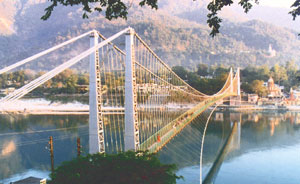
One of the most visited, the Lakshmana Jhula is a suspended bridge, extending from one bank of the Ganges to the other. The bridge is mythological significant because it is where Lakshman crossed the Ganga through on jute-rope-made bridge. Visitors can enjoy some impressive views of the Himalayan ranges from upon the bridge. Today, the Lakshmana Jhula connects two popular ashrams - Shivanand Ashram and Swarg Ashram.

Bharat temple in Rishikesh enshrines the statue of lord Vishnu with Shankha, Chakra, Gada and Padma in four different hands, made up of single saligram (the stone which is worshipped as form of lord Vishnu). Bharat is considered to be the incarnation of lord Vishnu and Bharat temple is mentioned in great Hindu holy epics Vishnu Puran, Mahabharata, Geeta, VamanPuran and NarsinghPuran.
Every year in the day of BasantPanchami the Shaligram is taken to Mayakund and bathed. The return journey is a grand procession. People believe that if any devotee perform 108 pradakshina (rounds) of lord Hrishikesh Narayan on the day of AkshyaTritiya, the lord fulfills all her/his wishes
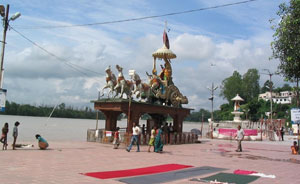
Triveni is a spot where three rivers meet. TriveniGhat in Rishikesh is the holy confluence of river Ganga, river Yamuna and river Saraswati. Devotees take dip at the holy confluence to get rid of all sins committed and achieve salvation.
Evening Aarati at TriveniGhat is popular among the people of Dehradun, Haridwar, whole of Uttarakhand, whole of India and the Hindu devotees outside India. you will be enchanted with the floating diyas, flowers and the singing of sacred Mantras and bhajans at TriveniGhat. The huge statue of lord Shiva sitting in bull and the statue of Krishna-Arjun in chariot depicting the initiation of Mahabharata war captivate you.

The place (or the bridge) is equally popular with devotees and tourists. It remains suspended 3 km north of Rishikesh town. It attracts most visitors due to the fact that it lies just close to the popular ashrams - Geeta Bhawan and Swarg Ashram. Visitors cannot afford to miss the enchanting evening prayer (which lasts for 30 minutes) at the Geeta Bhawan ghat. Food lovers can head straight to the 50-year-old and the very famous Chotiwala Restaurant, located in Ram Jhula.

Geeta Bhawan is one of the oldest temple complexes situated by the side of Laxman Jhula on the banks of sacred Ganges in Rishikesh.
Gita Bhavan is dedicated as a Museum for puranic and mythological awareness for the common public. Building consists of a very large complex comprising discourse halls and over 1000 rooms available free of charge for the stay of devotees. For the convenience of the devotees, simple vegetarian food, kitchen and grocery items and Indian sweets are available at very moderate price.
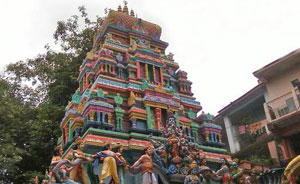
Thousands of devotees visit Neelkanth Mahadev every month throughout the year. It is situated on the summit of the mountain across the sacred Ganga River.
According to mythology this is the place where Lord Shiva drank the venom produced during agar Manthan which turned his throat blue and was thus the place was named as Neelkanth. Neelkanth and Mahadev are names of Lord Shiva.
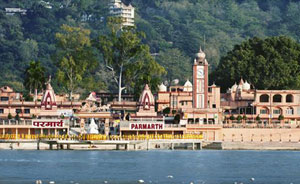
Across the Ramjhoola Bridge stands the mammoth Parmarth Niketan Ashram. The ashram has hundreds of rooms. It conducts many religious programmes. Foreigners can stay only with special permission.

One of the oldest ashrams in Rishikesh, its founder Swami Vishudhanand was also known as the 'Kali Kamli Wala' (One with The Black Blanket). Today the Kali Kamliwala Kshetra is a mammoth organization embracing many activities.
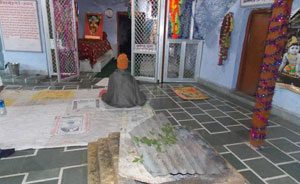
Vashishta Gufa is a famous attraction for meditation, located at the bank of River Ganga, this gufa is situated at a distance of 16 km from Rishikesh.
It takes about an hours drive on the Rishikesh Badrinath Highway to reach Vashishta Gufa. For the adventure seeker, this place provides with camping facility.

Kunjapuri Devi Temple is located on a hillock around 15 km away from Rishikesh. This temple is dedicated to one of the thirteen most important goddesses of Shivalik range.
The temple is well-known among the travellers as it gives a beautiful view of the sunrise and the sunset from the greater Himalayan peaks.